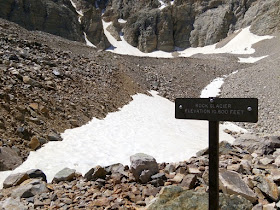I saw splashes of yellow and went over to check out these flowers, which I had never seen before. (Still haven't had time to look them up--the last few weeks have been extremely hectic.)
We continued on the uneven footing and reached this sign: Rock Glacier, Elevation 10,800 feet. But it still continued!
So onward we went, up towards the real glacier, which is still covered with snow. For years I was skeptical that it was a real glacier. I worked a couple seasons up in Glacier Bay in Alaska, and we took glaciers pretty seriously. Our criteria were they had to be moving, at least an acre in size, and consist of ice. A few years ago I got a good look at the glacier from the summit ridge of Wheeler Peak and I saw that the glacier is at least an acre, although most of it is at a very steep angle; has some blue color, which indicates ice; and has crevasses, which indicates movement. In addition, the latest peer-reviewed publication about it (Bevis and Osborne) call it a glacier. Right now, it's snow-covered (see photo below), but that snow is melting rapidly and soon the blue and crevasses will be evident.
We saw many patches of rock on top of the snow. The Prospect Mountain Quartzite is rather crumbly, and that contributes to the rock glacier. It's not a good idea to get too close to the walls.
The snow was rather soft, and I thought it might be a nice change to have soft footing than the jumbly talus. So Andrew and I headed across the big snow patch at the top towards the glacier.
Eventually it got too steep, so it was time to sit down and slide. Whee! It was fun.
Andrew didn't look so sure, but he gave it a try.
I was keeping my eye out for Black Rosy-Finches on the glacier and was delighted to see three. They breed up in that area. They are mostly black with white patches on their heads. You can see a fuzzy one in the photo below under the "e."
We had come up the right-center part of the glacier and decided to go down the left side, where I had noted a continual patch of snow.
We found lots of green bugs--Hemiptera.
The continuous snow gave us an opportunity to practice our glissading skills. That takes some balance!
We came across some pink snow and I got excited again. This is watermelon snow, where bacteria are producing that color. They in turn become a food source for bigger creatures. Just like yellow snow, don't eat the pink snow.
We found the researchers on the way down the trail; they had been delayed. It was a good reconnaissance of the rock glacier area, and I was able to share with some birders that there were indeed Black Rosy-Finches present. Here's to topography that allows for visiting snow in July!













lol I would LOVE to slide down the glacier!!!!
ReplyDeletethe colorful rock did almost look petrified
ReplyDelete